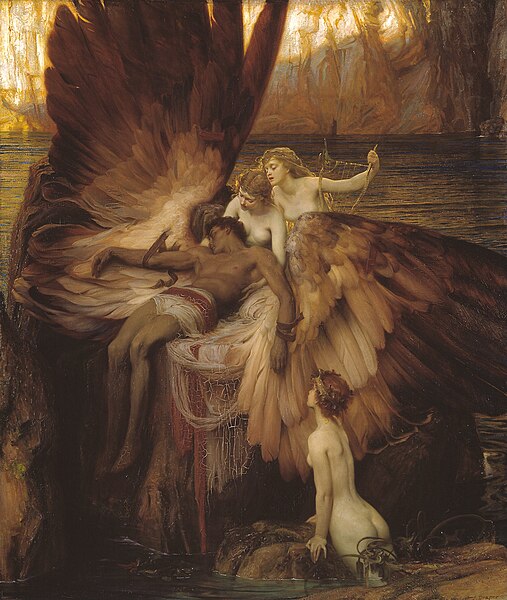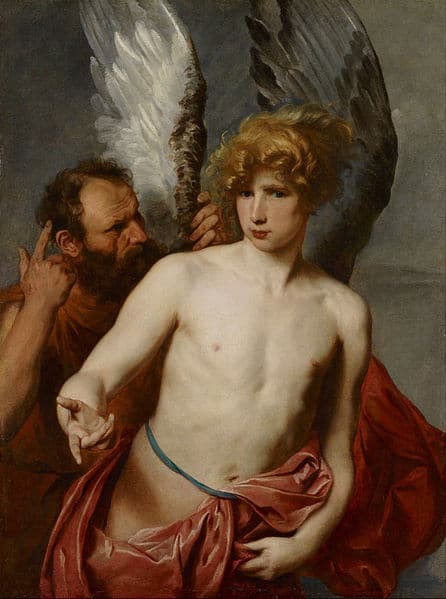In the vast tapestry of Greek mythology, few tales are as poignant as that of Icarus. A symbol of both ambition and the perils of hubris, Icarus’ story serves as a timeless reminder of the boundaries nature sets and the consequences of overstepping them.
Icarus Key Facts
| Parents | Daedalus and a slave named Naucrate |
| Partners | None |
| Siblings | None known |
| Offspring | None |
| Other names | None |
| Roman name | Icarus (unchanged) |
| Best Known Myth | His flight too close to the sun |
Name and Etymology
The name “Icarus” doesn’t have a clear etymology in Greek, but its resonance throughout history is undeniable. It’s become synonymous with both ambition and heedlessness. In Roman adaptations of the myth, the name remains unchanged, a testament to the story’s universal appeal and recognition. Over time, Icarus has been invoked in various contexts, symbolizing the human spirit’s aspiration and the dangers of overreaching one’s limits.

Icarus’ Family and Relationships
Icarus was the son of the famed craftsman and inventor, Daedalus, The Labyrinth’s Mastermind, and a slave named Naucrate. Little is known about his early life. However, his story closely connects with his father’s brilliance. Because of Daedalus’ actions, he and his son faced the anger of King Minos of Crete. Consequently, they found themselves imprisoned in the Labyrinth that Daedalus himself had crafted.It was this imprisonment that led to the crafting of the iconic wings and the subsequent tragic flight. Icarus, in many ways, was a victim of circumstances beyond his control, a young man caught in the crossfire of adult conflicts and ambitions.
Myths about Icarus
The myth of Icarus is a poignant tale that intertwines themes of ambition, hubris, and the inherent dangers of defying natural boundaries.
The Crafting of the Wings and the Dream of Flight
Daedalus, Icarus’ father, was a master craftsman and inventor. When he and Icarus were imprisoned on the island of Crete by King Minos, Daedalus devised a plan for their escape. He meticulously crafted two pairs of wings using feathers and beeswax. Before their daring escape, Daedalus instructed Icarus on how to use the wings, emphasizing the importance of maintaining a middle course between the sea and the sun. The sea’s dampness would weigh down the wings, while the sun’s heat would melt the wax.
As they took flight, the sensation was exhilarating. For Icarus, the youngest of the two, the thrill of flying was intoxicating. The vastness of the sky, the freedom of the open air, and the sheer joy of defying gravity were overwhelming.
Icarus’ Fateful Ascent
As they soared over the ocean, Icarus, filled with youthful exuberance and perhaps a touch of recklessness, began to climb higher and higher. The warnings of his father faded as the allure of the sun beckoned him. Drawn to its radiant glow, Icarus ventured too close. The heat began to soften the wax that held his feathers in place. As the wax melted, the feathers loosened and began to fall away. Realizing his peril too late, Icarus desperately flapped his now featherless arms. But it was in vain. He plummeted into the sea below, meeting a tragic end.
Legacy of the Tale
The spot where Icarus fell was named after him, becoming known as the Icarian Sea. Daedalus, heartbroken and filled with guilt over the loss of his son, eventually found refuge in Sicily, under the protection of King Cocalus. But the shadow of Icarus’ tragic flight haunted him for the rest of his days.
The tale of Icarus serves as a powerful reminder of the dual nature of ambition. While it drives individuals to break boundaries and achieve greatness, unchecked ambition, devoid of caution, can lead to one’s downfall. The story also underscores the importance of heeding wise counsel, especially when venturing into the unknown.
Depiction And Characteristics
Icarus is often depicted as a young man, sometimes a teenager, with wings attached to his back. The most poignant images capture the moment of his fall, a blend of ecstasy and terror. His story, while tragic, is also a testament to the human spirit’s desire to break free from constraints, to reach heights previously deemed unattainable.
His personality, as gleaned from the myths, is one of youthful exuberance, curiosity, and perhaps a touch of recklessness. His tragic end is not a result of malice but of getting carried away by the sheer joy of flight.
Symbols associated with Icarus include feathers, the sun, and the sea. Each represents a different facet of his tale – the feathers for the means of his flight, the sun for his ambition, and the sea for his tragic end.

Representations Of Icarus In Art
Icarus’ tragic tale has inspired countless artists throughout history. One of the most famous depictions is “The Fall of Icarus” by Pieter Bruegel the Elder. In this painting, Bruegel captures the moment of Icarus’ fall, but with a twist. Instead of making it the central event, he portrays it as a mere footnote in a larger, bustling scene, perhaps commenting on the indifference of the world to individual tragedies.
Another notable representation is “Landscape with the Fall of Icarus,” attributed to Bruegel but its authenticity is debated. Here, Icarus’ legs are seen protruding from the sea, while life goes on unaffected around him.
Mentions in Ancient Texts
The story of Icarus is ancient, with its roots in oral traditions before being penned down by classical writers. One of the earliest written accounts is found in Ovid’s “Metamorphoses.” Ovid paints a vivid picture of Icarus’ exhilaration during his flight and the subsequent horror of his fall. A poignant line from this text reads: “Icarus, audaciously, began to soar towards the heavens, drawing near to the scorching sun.”
Another mention can be found in the works of Apollodorus, who provides a more straightforward account of the tale. He is focusing on the technical aspects of the wings and Daedalus’ warning to his son.
Featured Image Credit: Franz Xaver Wagenschön, Public domain, via Wikimedia Commons
